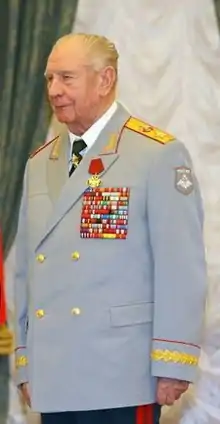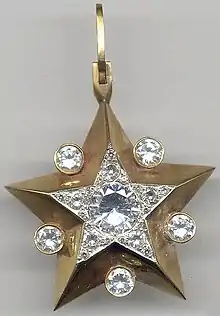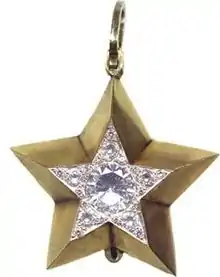Marshal's star
The marshal's star (Russian: маршальская звезда) is an additional badge of rank worn by marshals of the armed forces of the Soviet Union, and subsequently the Russian Federation. The armed forces of the former Soviet Union and the Russian Federation have two such insignia for higher military ranks, both in the form of a five-pointed star of gold and platinum with diamonds. They are worn around neck when in parade uniform (originally under the collar of the parade tunic, since 1955 on top of the necktie). There are two different sizes of star. Officially their names have changed, depending on what ranks received the right to wear them, and are known as the large marshal's star and the small marshal's star.

The marshal's star corresponds with the western use of the marshal's baton. On the death of the recipient, the award is returned to the diamond fund for re-use.[1]
In 2013, new shoulder insignias were instituted for generals of the army, fleet admirals, and generals of the army (air force), and additionally, these ranks are now entitled to the marshal's star of a new design—now in the pattern of a cross overlain with the Russian coat of arm's double-headed eagle in gold.
Recipients
The official name, size and number of diamonds correspond to the marshal's rank. Marshal's stars were first awarded to the marshals of the Soviet Union and admirals of the fleet of the Soviet Union. In time, smaller stars were awarded to "marshals of an arm of service" and "chief marshals of an arm of service", admirals of the fleet and later generals of the army of the Soviet armed forces.[2]
Large marshal's star

The "large marshal´s star" was the distinction insignia for OF10-ranks as follows:
- Since 2 September 1940 to marshal of the Soviet Union
- Since 3 March 1955 to admiral of the fleet of the Soviet Union
- Since 1993 to marshal of the Russian Federation
It is a gold five-pointed star with smooth diagonal rays on the front side. In the center is a platinum, five-pointed star with diamonds. The diamonds in the center have a total weight of 2.62 carats and in the rays there are 25 diamonds weighing a total of 1.25 carats. Between the edges of rays are 5 diamonds weighing a total of 3.06 carats. The diameter of the gold star is 44.5 millimetres (1.75 in) and the platinum stars are 23 millimetres (0.91 in) in diameter. The star has a depth of 8 millimetres (0.31 in).[2]
The marshal's star has a triangular eyelet in the upper beam which is connected to an oval eyelet measuring 14 millimetres (0.55 in). The marshal's star is suspended by a 25 millimetres (0.98 in) moire ribbon. The total weight of the large marshal's star is 36.8 grams (1.30 oz). Approximately 200 of this type of marshal's star were produced.[2]
Russian Federation
In the armed forces of the Russian Federation, the large marshal's star was the defining insignia for the rank Marshal of the Russian Federation until 21 January 1997.
Small marshal's star
Soviet Union

The "small marshal´s star" was the distinction insignia for F9-ranks as follows:
- Since February 27, 1943 to Marshal of the branch ranks:
- Marshal of the artillery, marshal of the aviation and marshal of the armored troops
- Since March 20, 1944 followed by the ranks:
- Marshal of the signal troops and marshal of the engineer troops
- Since June 5, 1962: admiral of the fleet
- Since November 1, 1972: general of the army
There was no formal decree pertaining to use the "marshal´s star – small" as distinction insignia to chief marshal of the branch ranks. However, after promotion from "marshal of the branch" to "chief marshal of the branch" the appropriate general officers continued to wear the "marshal´s star – small".
The decoration is a five-pointed gold star with smooth dihedral rays on the obverse. On top of the gold star there is a smaller five-pointed star made of platinum. In the center of the platinum star there is a 2.04-carat diamond. In the rays of platinum star there are twenty five 0.91-carat diamonds. The total diameter of the gold star is 42 millimetres (1.7 in) and it weighs 35.1 grams (1.24 oz). It is connected to a moire ribbon in the same way as the large star.[2] About 370 small marshal's stars have been produced.[2]
Russian Federation
In the armed forces of the Russian Federation, the small marshal's star was the defining insignia for the ranks general of the army and admiral of the fleet.
Ribbons
A Marshal of the Soviet Union's star used a red satin ribbon suspension; ribbons for marshals of a branch varied accordingly: gold for artillery, light blue for aviation, burgundy for armoured troops, crimson for engineers, blue for signals, and turquoise for the navy.[2]
References
- "Маршальская звезда: история описания и фотографии маршальской звезды (Marshal's star: a description and photographs of the marshal's star)" (in Russian). Журнал СЕНАТОР (SENATOR journal). Archived from the original on 2012-03-25. Retrieved 2011-09-16.
- Кузнецова, Андрея; Пака, Игоря. "Маршальская Звезда (marshal's star)" (in Russian). Ордена и Медали СССР (Orders and Medals of the Soviet Union). Retrieved 2011-09-16.
- Ministry of Defense Military Uniform Regulations, 1988 edition, pp. 99, 101.